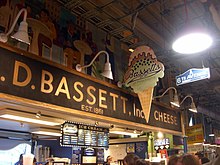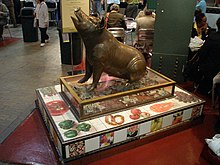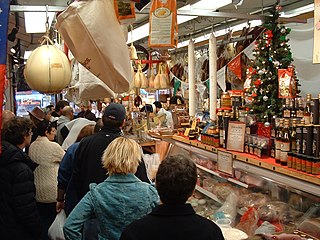
The Italian Market is the popular name for the South 9th Street Curb Market, an area of South Philadelphia featuring awning covered sidewalks, curb carts, grocery shops, cafes, restaurants, bakeries, cheese shops, butcher shops, etc., many with an Italian influence. The historical heart of the market is the area of 9th Street between Christian Street and Washington Avenue, the commercial district chartered in 1915, the South Ninth Street Business Men's Association, covered the area between Catharine to Federal and Eighth to Tenth streets, and the market is now generally considered to extend from Fitzwater Street at the north to Wharton Street at the south. The term Italian Market is also used to generally describe the surrounding neighborhood between South Street to the North and Wharton Street to the South running a few blocks to the east and west of 9th street.

The Reading Company was a Philadelphia-headquartered railroad that provided passenger and freight transport in eastern Pennsylvania and neighboring states from 1924 until its acquisition by Conrail in 1976.
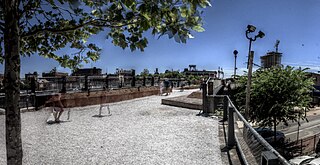
The Reading Viaduct, also called The Rail Park, is a disused elevated rail line in the Callowhill district of Philadelphia, Pennsylvania, United States that has been partly transformed into a rail trail.

Suburban Station is an art deco office building and underground commuter rail station in Penn Center in Philadelphia. Its official SEPTA address is 16th Street and JFK Boulevard. The station is owned and operated by SEPTA and is one of the three core Center City stations on the SEPTA Regional Rail and one of the busiest stations in the Regional Rail System.

The Center City Commuter Connection (CCCC), commonly referred to as "the commuter tunnel", is a passenger railroad tunnel in Center City Philadelphia, Pennsylvania, The tunnel was built to connect the stub ends of the two separate regional commuter rail systems, which were originally operated by Pennsylvania Railroad and the Reading Company, two rival rail companies.

Transportation in Philadelphia involves the various modes of transport within the city and its required infrastructure. In addition to facilitating intracity travel, Philadelphia's transportation system connects Philadelphia to towns of its metropolitan area and surrounding areas within the Northeast megalopolis.

The Pennsylvania Convention Center is a multi-use public facility in the Market East section of Philadelphia, Pennsylvania, designed to accommodate conventions, exhibitions, conferences and other events. The L-shaped complex occupies four city blocks.

Jefferson Station is an underground SEPTA Regional Rail station located on Market Street in Philadelphia, Pennsylvania. It is the easternmost of the three Center City stations of the SEPTA Regional Rail system and is part of the Center City Commuter Connection, which connects the former Penn Central commuter lines with the former Reading Company commuter lines. In 2014, the station saw approximately 26,000 passengers every weekday.

Port Richmond is a neighborhood in the River Wards section of Philadelphia, Pennsylvania, United States. It is notable for its extremely large Polish immigrant and Polish American community, and it has been known as the Little Poland of Philadelphia. The neighborhood is also home to a large Irish American community and sizable German, Lithuanian, Italian, and Puerto Rican communities, along with a historic Jewish community, as represented in the various churches and organizations. In more recent years, a sizable Albanian community has moved in. The Richmond Zip Code is 19134. A small portion of the neighborhood, north of Castor Avenue, falls into the 19137 ZIP code.

Broad Street Station at Broad & Market streets was the primary passenger terminal for the Pennsylvania Railroad (PRR) in Philadelphia from early December 1881 to the 1950s. Located directly west of Philadelphia City Hall, the site is now occupied by the northwest section of Dilworth Park and the office towers of Penn Center.
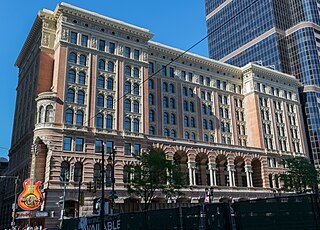
The Reading Terminal is a complex of buildings that includes the former Reading Company main station located in the Market East section of Center City in Philadelphia, Pennsylvania, United States. It comprises the Reading Terminal Headhouse, Trainshed, and Market.

Center City East is part of the downtown district known as Center City, Philadelphia, Pennsylvania, United States. The area is generally bounded by Arch Street to the north, Chestnut Street to the south, Juniper Street to the west, and 6th Street to the east. The area serves as one of the major retail centers in the city as well as the home of the Pennsylvania Convention Center.
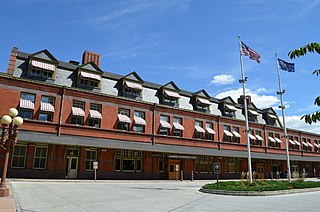
The Harrisburg Transportation Center is a railway station and transportation hub in Harrisburg, Pennsylvania. It is located on the eastern edge of Downtown Harrisburg between the intersections of Aberdeen and Market Streets and 4th and Chestnut Streets.

The cuisine of Philadelphia was shaped largely by the city's mixture of ethnicities, available foodstuffs and history. Certain foods have become associated with the city.

Philadelphia is the center of economic activity in both Pennsylvania and the four-state Delaware Valley metropolitan region of the United States. Philadelphia's close geographical and transportation connections to other large metropolitan economies along the Eastern Seaboard of the United States have been cited as offering a significant competitive advantage for business creation and entrepreneurship. Five Fortune 500 companies are headquartered in the city. As of 2021, the Philadelphia metropolitan area was estimated to produce a gross metropolitan product (GMP) of US$479 billion, an increase from the $445 billion calculated by the Bureau of Economic Analysis for 2017, representing the ninth largest U.S. metropolitan economy. Philadelphia was rated by the GaWC as a 'Beta' city in its 2016 ranking of world cities.
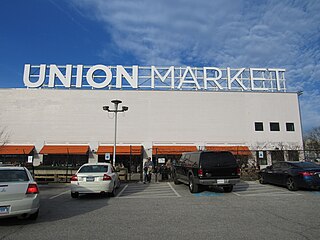
Union Market is a food hall located in Washington, D.C. It anchors the Union Market District, a neighborhood encompassing high-rise apartments, office buildings, retail, and entertainment options.
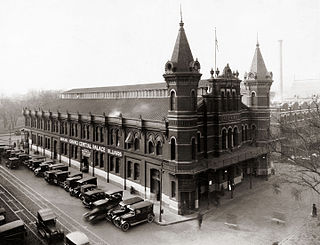
Center Market was a market hall in Washington, D.C. designed by architect Adolph Cluss which operated in Washington, DC from 1872 to 1931. The building was demolished in 1931 to be replaced by the National Archives Building. A market called Center Market had been in operation on the same block of land since 1802. In 1931, the name of Center Market was transferred over to the Northern Liberty Market located a few blocks north.

Spring Garden Street station was a train station in the Poplar neighborhood of Philadelphia. It was built by the Reading Railroad and located on the Reading Viaduct. Service to Spring Garden Street ended in 1984 with the opening of the Center City Commuter Connection, which bypassed the Reading Terminal, and the building was demolished in 2021.

The Ninth Street Branch was an elevated railway line in Philadelphia, Pennsylvania. It was operated by the Reading Company; ownership was split between the Reading and its subsidiary the Philadelphia, Germantown and Norristown Railroad. It was a four-tracked main line beginning at the Reading Terminal, the Reading's terminus in Philadelphia, and extending north into the city to a junction with the Bethlehem Branch. After the final bankruptcy of the Reading the line passed to Conrail and later SEPTA. The portion south of the Temple University station was abandoned in 1984 with the opening of the Center City Commuter Connection and is now known as the Reading Viaduct; the portion north is now part of the SEPTA Main Line.


